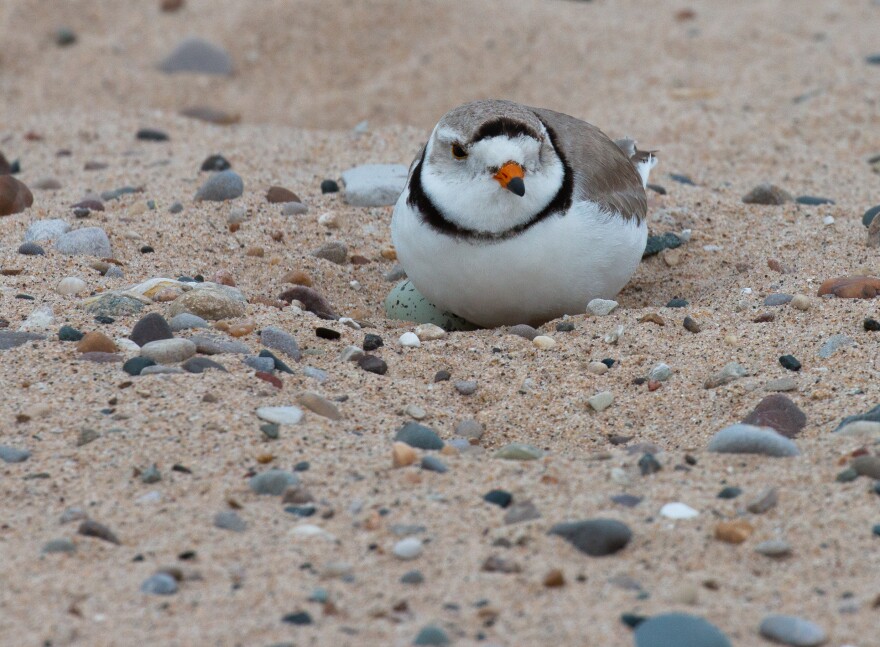Although it’s mid-July, it’s a chilly and windy morning on the Sleeping Bear Dunes Lakeshore.
We’re scouting for two known families of piping plovers that are nesting along the Lake Michigan shoreline.
Alice Van Zoeren, with the Great Lakes Piping Plovers Conservation Team, and Vince Cavalieri, with the National Park Service, lead the expedition to tag the newborn plovers.
"Maybe we should put on our radios, so we can get spread out," Van Zoeren said to the research team. "Go down to the shore, and the rest of us walk along the back edge here, and see if they pop out.
The seven of us split up, peering through binoculars.
![Vince Cavalieri [right]](https://npr.brightspotcdn.com/dims4/default/f8e1774/2147483647/strip/true/crop/3598x2733+0+0/resize/880x668!/quality/90/?url=http%3A%2F%2Fnpr-brightspot.s3.amazonaws.com%2Fac%2F36%2F420c98684a0d832298732fe27dad%2Fimg-3780.jpg)
The birds’ nests are fenced and their surrounding area is sectioned off with orange ropes. Cavalieri said it’s against the law to cross this “psychological fencing,” and pets are prohibited on this beach.
“That’s to give the plovers some room within this ponded area to feed without getting disturbed by people," Cavalieri said. "We have a more substantial fence up here, with all those signs.”
Thanks to the park’s monitors, who regularly patrol the beach, we knew to look for three chicks between the two nests.
But that didn’t make finding them easy. Piping plovers are small, sandy-gray-colored birds. Adults are typically seven inches tall, and their chicks are much smaller.
“We think the chicks are likely to be in this cobble pin on this flat part of the beach," Cavalieri said. "But if they’re not moving, they can be very hard to see. They blend in very well with the rest of the beach.”
We finally spotted the one of the chicks.
Cavalieri [into the walkie talkie]: Alice, do you want me to move toward the shore or wait for Scott to move up?
Van Zoeren [over the radio]: Yes, you should move up. Everyone else, move this way, we need to get an eye on the second chick.”
Once both were in sight, we surrounded the chicks and slowly closed in on them, making sure to stay quiet and calm in order to prevent unnecessary stress. Cavalieri tossed a mesh “chick-catcher” over the birds.

The research team worked quickly to weigh the chicks – the first two were both 24 grams. The team then attached small bands to the birds’ legs and swabbed their mouths for a DNA sample.
Within just a couple of minutes, the chicks were released. We watched them hobble away with their new yellow and white bracelets - into the warm and protective wings of their relieved mom.
Homsi: “Is letting them go the best part?”
Everyone in agreement: “Oh yeah, by far...”
Van Zoeren: “Seeing them back with their parents is the best.”
We repeated the process with the second family. It’s now the tail-end of the nesting season, so most of the chicks born this year across the Great Lakes have already been banded.
Soon, the families will split apart to head south, either to the Gulf of Mexico or the southeast Atlantic coast.

Cavalieri said the chick-banding allows researchers to keep track of the birds’ populations and track their habitats.
“We've spent a ton of energy and time researching the breeding grounds, figuring out better ways to protect them," Cavalieri said. "But now, we kind of need to do the same thing on the wintering grounds and in their migration cycles.”
At their lowest point in 1990, there were only 12 breeding pairs left. Today, the Great Lakes piping plover population is at a record-high of 80 pairs.
“We aren't super close to extinction anymore," Cavalieri said. "The question now is getting them to that next step of recovery, where we're shooting for this 150-breeding pair mark, and I still think we're still far away from that.”
Cavalieri said while the tiny pipers are near and dear to his heart, their conservation isn’t just for their sake. Piping plovers are considered an “umbrella species..."
“...because they're so rare, and they occur in this rare, fragile ecosystem, the protection we give piping plovers acts as an umbrella to the entire ecosystem,” Cavalieri said.

Some beneficiaries of the plover’s conservation include another bird, the Red Knot... the purple-flowered, Pitcher's thistle - a plant that almost exclusively grows on the Lake Michigan shoreline... Houghton’s golden rod, Lake Huron tansy, and the Lake Huron locust – a little brown grasshopper.
“Beyond the umbrella species thing, piping plovers have a right to exist," Cavalieri said. "I want to keep them as a part of our natural heritage for future generations to see and hear on the beaches.”
The chicks we banded today are between two- and three- weeks old. But give it a month, and they’ll soon take to the sky for their first real journey. The team can only hope to see them return next year.

Editor's note: Plover is technically pronounced "pluh-ver." However, WCMU made the decision to pronounce plover like "clover" to keep the pronunciation consistent with the quoted researchers.




![Brenda Archambo [left] presents to a group about sturgeon conservation, amid the spawning season on Black River.](https://npr.brightspotcdn.com/dims4/default/11e6e6c/2147483647/strip/true/crop/1239x690+0+0/resize/280x156!/quality/90/?url=http%3A%2F%2Fnpr-brightspot.s3.amazonaws.com%2F39%2F76%2Fe0a219ba4e23b8e2db2046d3c4f5%2F346969853-581674030611609-6169316743171382075-n.jpg)
